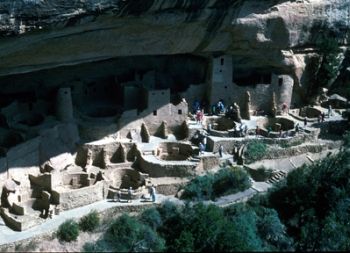
Publisher:
Bonnie King
CONTACT:
Newsroom@Salem-news.com
Advertising:
Adsales@Salem-news.com

~Truth~
~Justice~
~Peace~
TJP
Feb-19-2008 15:02

 TweetFollow @OregonNews
TweetFollow @OregonNews
WSU Researchers Study Fate of an Ancient American Southwest Civilization
Salem-News.comEvidence suggests that the Anasazi fled the region and joined related groups to the south and east.
 While the cliff dwellings of Mesa Verde are easily the best known of these settlements, the region is dotted with some 4,000 known archaeological sites, including communities which supported as many as several hundred families. |
(PULLMAN, Wash.) - Using computer simulations to synthesize both new and earlier research, a team of scientists led by a Washington State University anthropology professor has given new perspective to the long-standing question of what happened more than 700 years ago to cause the ancestral Pueblo people known as the Anasazi to abruptly end their 700-year-long occupation of the now-famous cliff dwellings of Mesa Verde and other nearby communities in southwestern Colorado.
In an article to be published in the upcoming issue of "American Scientist," WSU Regents Professor Tim Kohler and three colleagues describe how computer simulation techniques were used to integrate nearly a century's worth of archaeological research with new climatic, ecological and demographic data to analyze two major cycles in population growth and decline among the ancient Anasazi.
Ultimately their data suggests that the final population collapse within the region resulted from a complex set of environmental changes and societal pressures-including climate change, population growth, increasing competition for resources and escalating conflict and violence among local societies.
Preserved in 1906 by President Theodore Roosevelt as Mesa Verde National Park, the ancestral Pueblo homeland also encompasses what is known today as the Four Corners Region of the American Southwest, an area marked by the intersection of Arizona, Colorado, New Mexico and Utah.
While the cliff dwellings of Mesa Verde are easily the best known of these settlements, the region is dotted with some 4,000 known archaeological sites, including communities which supported as many as several hundred families.
Archaeological evidence has shown that the Anasazi inhabited the region and prospered there from about A.D. 600 until sometime in the late 1200s, when they abandoned their communities abruptly - often within the span of a single generation - and migrated southward.
Since the discovery of the Mesa Verde sites in the late 19th century, archaeologists have frequently invoked single factors-such as climate change or conflict - as explanations for the depopulation of more than 600 cliff dwellings in Mesa Verde, as well as the thousands of small residences and large community centers across the Four Corners. More recently, some scholars have even suggested that better conditions or new types of social organization may have drawn the Pueblo people south.
In their recent article, however, Kohler and co-authors Mark D. Varien, Vice President of Programs at the Crow Canyon Archaeological Center in Cortez, Colo., Aaron M. Wright, WSU anthropology doctoral candidate and Preservation Fellow at the Center for Desert Archaeology, and Kristin A. Kuckelman, Senior Research Archaeologist at the Crow Canyon center, say their research demonstrates the factors leading to the Anasazi exodus were likely far more complex.
"Instead, it was a cascade of events that included climate-induced immigration from peripheral regions resulting in overpopulation, in turn generating resource depletion that was exacerbated by a decline in maize productivity.," the authors write. "These changes provoked conflict, which in turn induced more scarcity. As these societies began to lose population, they also functioned less successfully and became vulnerable to aggression."
In the end, the researchers write, "violence and famine provided potent motives for departure. Evidence suggests that the survivors of these final events moved south, following kin who had pioneered migration streams in that direction at least a century earlier."
Archaeological evidence, in combination with some oral traditions among modern Pueblos, suggest that the Anasazi fled the region and joined related groups to the south and east, mostly along the northern Rio Grande of New Mexico, Kohler and his colleagues conclude.
"The societies that they joined and helped build there were substantially different from those they left behind," the authors note. "Perhaps this suggests the degree of trauma that the Pueblo people experienced toward the end in the Four Corners region, and why they never returned to farm the Mesa Verde."
Kohler earned a doctorate in Anthropology from the University of Florida in 1975. Since joining the faculty of WSU in 1978, he has increasingly specialized in Southwestern archeology.
In the late 1970s through the mid-1980s, he collaborated with Anthropology professor emeritus William D. Lipe on the Dolores Archaeological Program in southwestern Colorado.
Since then, he has directed excavations in Bandelier National Monument in New Mexico, and an NSF Biocomplexity Project devoted to understanding the causes for changes in settlement systems in southwestern Colorado between A.D. 600 and 1300. He is a Research Associate at the Crow Canyon Archaeological Center, Cortez, and an External Professor at the Santa Fe Institute, New Mexico.
Articles for February 18, 2008 | Articles for February 19, 2008 | Articles for February 20, 2008
Salem-News.com:





Terms of Service | Privacy Policy
All comments and messages are approved by people and self promotional links or unacceptable comments are denied.
[Return to Top]
©2025 Salem-News.com. All opinions expressed in this article are those of the author and do not necessarily reflect those of Salem-News.com.